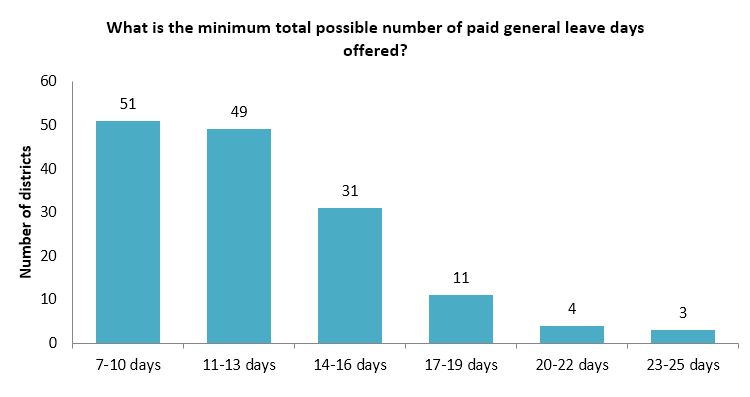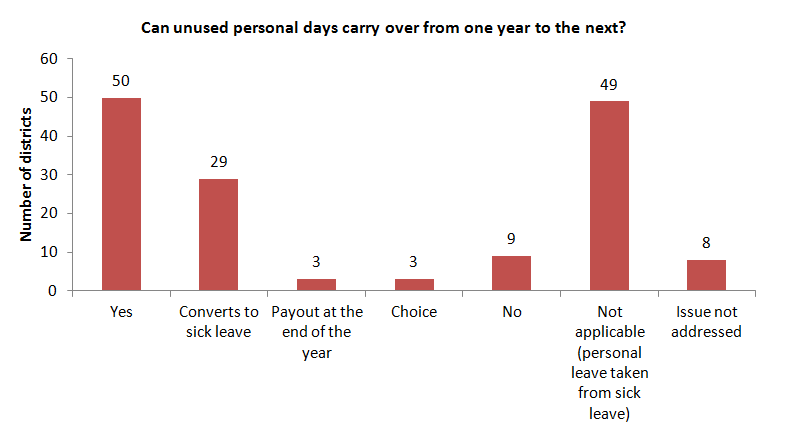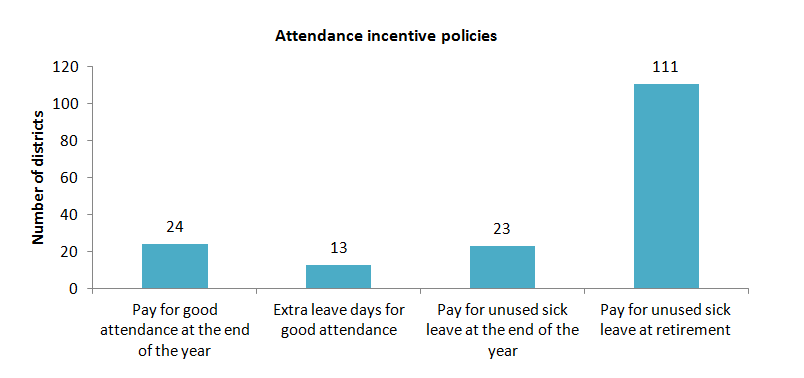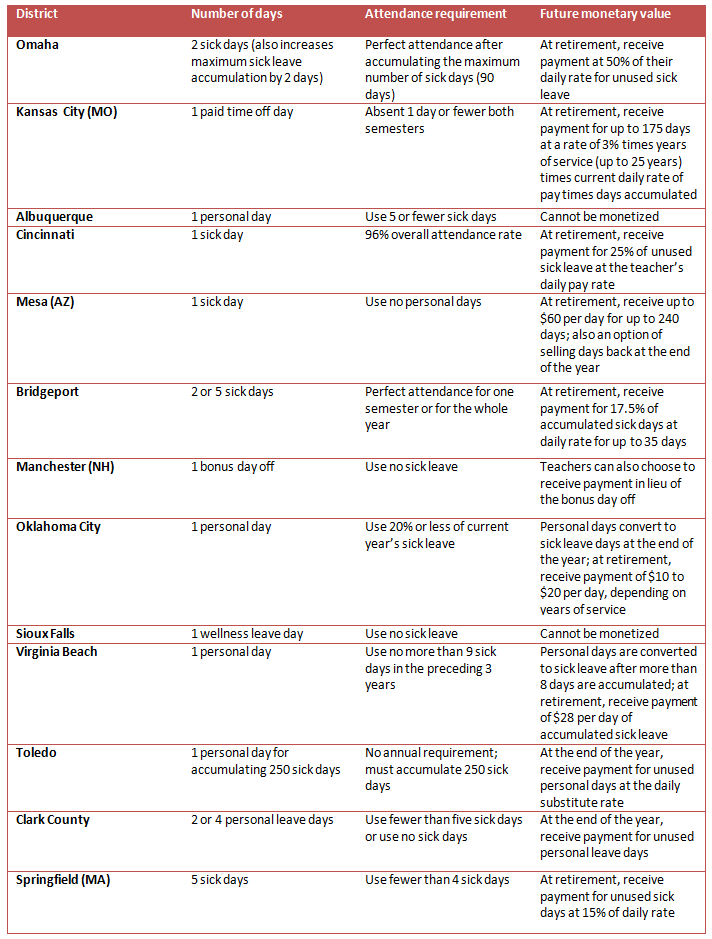District Trendline, previously known as Teacher Trendline, provides actionable research to improve district personnel policies that will strengthen the teacher workforce. Want evidence-based guidance on policies and practices that will enhance your ability to recruit, develop, and retain great teachers delivered right to your inbox each month? Subscribe here.
Let us
know what you think, take our reader survey! We want to learn more about our readers in order to improve
the District Trendline and better serve your needs. Click here to take our brief
survey.
With the release of new federal data on absences, teacher
and student attendance is back in
the news. This month, we take a look at how much leave time teachers
receive each year and what policies school districts use to incentivize higher
teacher attendance, from allowing sick and personal leave to carryover from
year to year to paying teachers for unused leave when they retire.
General leave
School districts offer teachers some combination of sick
leave and personal leave, but the variations in how they define various categories
of leave can make it difficult to compare across districts. To address this
issue, NCTQ uses the term general leave,
in which we include all leave days that districts label as sick or personal, as
well as other kinds of routine leave taken for personal reasons such as
religious observances or voting leave. This definition makes an apple-to-apple
comparison possible among districts. Click
here for more information on how NCTQ categorizes leave.)
Across districts in the database, the minimum average number
of paid general leave days available to teachers is 12.8 days, down slightly
from 13.1 days when we looked at this same topic last year. The drop is likely due to the addition of
districts to our database.

As in years past, Hartford (25 days), Toledo (24 days), and Burlington(VT) (24 days) provide the most paid general leave. Two Texas
districts, Conroe and Garland, provide only seven days of
general leave, the lowest number of days among any of the districts in the Teacher
Contract Database.
While most districts (86 percent) provide the same amount of
leave to all of their teachers, there are a few districts that offer differing
amounts of leave to different groups of teachers. Typically, these districts
provide more leave to teachers as they gain experience. For example, in Pittsburgh first and second year
teachers receive no personal days, but beginning in their third year, teachers can
take up to two personal days. Indianapolis is a notable exception
to this general rule: first year teachers receive 70 hours of sick leave while
all other teachers receive only 56 hours.
Leave carryover
All of the districts in the Teacher Contract Database allow
sick leave to carry over from year to year, although 40 percent of districts
place a limit on the amount of sick leave accumulation. When it comes to allowable
carryover of personal leave, about a third of districts (34 percent) allow days
to carry over from one year to the next. Some districts (22 percent) offer an
incentive to teachers to not take their personal days. For example, 29
districts convert unused personal days into sick leave which then carry over and
two Ohio districts, Dayton and Toledo, as well as Clark County (NV), pay teachers for
unused personal days at the end of each year.

In Mobile (AL), Birmingham (AL), and Norfolk (VA), teachers can choose
what to do with unused personal days. In Mobile and Birmingham, teachers can
convert unused personal days to sick leave or receive payment for unused days;
in Norfolk, teachers can convert unused days to sick leave or carry over the
personal days at a rate of one carryover day for two days unused.
There are also two districts that have policies regarding
unused personal days specifically targeted at promoting teacher attendance. In Portland (ME), teachers with great
attendance (having used four or fewer sick days each year) may carry over up to
three personal days. In Indianapolis, all teachers may
convert unused personal days to sick days, but teachers with an attendance rate
of 97 percent or higher are allowed to carry over unused personal time too,
accumulating up to 3.5 days.
Attendance incentives
In addition to allowing leave to carry over from year to
year, districts implement a variety of other policies intended to discourage
teachers from taking unnecessary leave. By far the most common incentive is for
districts to pay teachers for any unused sick leave at retirement: 74 percent of districts in the database offer teachers
compensation for unused time at the end of their careers.

Of the 24 districts that offer pay for good attendance at
the end of the year, seven provide additional pay for unused days beyond a
specified number. For example, in Oklahoma City teachers receive $35
for each unused sick day after they have accumulated 201 days. Some districts
(15) provide additional pay for teachers who meet the district’s defined attendance
benchmarks. For example, four districts (the District of Columbia, Sioux Falls, Manchester (NH), and Volusia County (FL)) offer bonuses
to teachers with perfect attendance. Other districts, such as Houston and Jordan (UT), offer bonuses on a
sliding scale based on how few days a teacher was absent. The remaining two
districts in this category are Pittsburgh and Los Angeles. In Pittsburgh,
teachers who meet an attendance benchmark are entered into a drawing for $500
each semester. In Los Angeles, all teachers in any given school receive bonuses
if overall attendance rates in that school are increased.
Irony aside, there are a number of districts (13 out of 149)
which reward good attendance by giving teachers additional leave time. This
additional leave time can be monetized; in fact, only in Albuquerque and Sioux Falls does it appear that a
teacher whom the district rewarded with extra leave cannot at any point
monetize that leave.
Districts rewarding teachers
for good attendance with additional leave

Leave restrictions
The majority of districts (80 percent) place restrictions on
when teachers can take personal leave. The most common restrictions are on days
that would extend a pre-existing break or holiday (such as the Friday before winter
break) and in the periods right at the beginning and end of the school year.

Connecting policy to
outcomes?
Recently, the Department of Education released the 2013-2014
Civil Rights Data Collection, which
includes the number of teachers absent more than 10 days in 2013-2014 at a
school level. We aggregated this reported teacher attendance data at the
district level in order to relate the percentage of their teacher workforce
absent more than 10 days to the information on district leave and attendance
incentives in the Teacher Contract database.[1]
You can access our aggregated data here
or the complete data set from the Department of Education here.
We found no correlation between the amount of leave time
districts give teachers and the percentage of teachers who are absent more than
10 days. We also looked at the relationship between the percent of teachers
absent more than 10 days and other various attendance incentive policies but again
found no clear patterns. This is in keeping with our findings from Roll Call: The importance of teacher
attendance where we found no relationship between any specific policy
and teacher absenteeism.
Since evidence connecting attendance incentive policies to
higher teacher attendance seems to be difficult to find, it’s worth raising the
question: are these policies the smartest place for districts to invest their
resources or are there other ways to encourage strong teacher attendance?
Want to dig into the data? Get all the details on district
leave policies and attendance incentives by creating
a custom report from the Teacher Contract Database. Want to give us
feedback? Take
our reader survey and let us know how to make the Teacher Trendline better.
The Teacher Contract Database includes information on over 145 school
districts in the United States: the 60
largest districts in the country, the largest district in each state, the member
districts of the Council of Great City Schools, and districts that won the
Broad Prize for Urban Education. The database features answers to over 100
policy questions and provides access to teacher contracts, salary schedules,
and board policies in addition to relevant state laws governing teachers.
[1]
Specifically, we removed charter schools from each district and then added up
the number of teachers chronically absent in each district, divided by the
total number of full-time equivalent teachers reported to get the percentage of
teachers in each district who were absent more than 10 days. You can download
our aggregated, district-level data here.
More like this

Does paid parental leave for teachers pay off?

The data and analyses district leaders used to support their work in 2024

Myth-busted: Teachers don’t skip school

